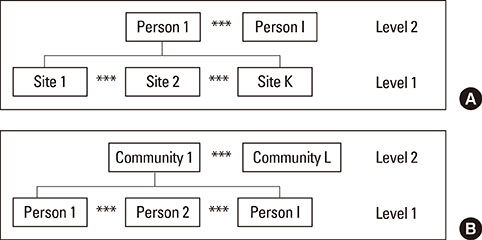J Periodontal Implant Sci.
2015 Feb;45(1):2-7. 10.5051/jpis.2015.45.1.2.
Analysis of periodontal data using mixed effects models
- Affiliations
-
- 1Department of Psychology, Sungshin Women's University, Seoul, Korea.
- 2Department of Health Policy Management, College of Health Science & Department of Public Health Sciences, Graduate School, Korea University, Seoul, Korea. kimhaey@korea.ac.kr
- KMID: 2027826
- DOI: http://doi.org/10.5051/jpis.2015.45.1.2
Abstract
- A fundamental problem in analyzing complex multilevel-structured periodontal data is the violation of independency among the observations, which is an assumption in traditional statistical models (e.g., analysis of variance and ordinary least squares regression). In many cases, aggregation (i.e., mean or sum scores) has been employed to overcome this problem. However, the aggregation approach still exhibits certain limitations, such as a loss of power and detailed information, no cross-level relationship analysis, and the potential for creating an ecological fallacy. In order to handle multilevel-structured data appropriately, mixed effects models have been introduced and employed in dental research using periodontal data. The use of mixed effects models might account for the potential bias due to the violation of the independency assumption as well as provide accurate estimates.
MeSH Terms
Figure
Reference
-
1. Gilthorpe MS, Griffiths GS, Maddick IH, Zamzuri AT. An application of multilevel modelling to longitudinal periodontal research data. Community Dent Health. 2001; 18:79–86.2. Gilthorpe MS, Griffiths GS, Maddick IH, Zamzuri AT. The application of multilevel modelling to periodontal research data. Community Dent Health. 2000; 17:227–235.3. Gilthorpe MS, Maddick IH, Petrie A. Introduction to multilevel modelling in dental research. Community Dent Health. 2000; 17:222–226.4. Gilthorpe MS, Mayhew MT, Bulman JS. Multilevel survival analysis of amalgam restorations amongst RAF personnel. Community Dent Health. 2002; 19:3–11.5. Gilthorpe MS, Cunningham SJ. The application of multilevel, multivariate modelling to orthodontic research data. Community Dent Health. 2000; 17:236–242.6. Hannigan A, Lynch CD. Statistical methodology in oral and dental research: pitfalls and recommendations. J Dent. 2013; 41:385–392.
Article7. Macfarlane TV, Worthington HV. Some aspects of data analysis in dentistry. Community Dent Health. 1999; 16:216–219.8. Laird NM, Ware JH. Random-effects models for longitudinal data. Biometrics. 1982; 38:963–974.
Article9. Mason WM, Wong GM, Entwistle B. Contextual analysis through the multilevel linear model. In : Leinhardt S, editor. Sociological methodology. San Francisco: Jossey-Bass;1983. p. 72–103.10. Bolker BM, Brooks ME, Clark CJ, Geange SW, Poulsen JR, Stevens MH, et al. Generalized linear mixed models: a practical guide for ecology and evolution. Trends Ecol Evol. 2009; 24:127–135.
Article11. Liang KY, Zeger SL. Longitudinal data analysis using generalized linear models. Biometrika. 1986; 73:13–22.
Article12. Kim HY, Preisser JS, Rozier RG, Valiyaparambil JV. Multilevel analysis of group-randomized trials with binary outcomes. Community Dent Oral Epidemiol. 2006; 34:241–251.
Article13. Diez Roux AV. A glossary for multilevel analysis. J Epidemiol Community Health. 2002; 56:588–594.
Article14. Hu FB, Goldberg J, Hedeker D, Flay BR, Pentz MA. Comparison of population-averaged and subject-specific approaches for analyzing repeated binary outcomes. Am J Epidemiol. 1998; 147:694–703.
Article15. Tu YK, Gilthorpe MS, Griffiths GS, Maddick IH, Eaton KA, Johnson NW. The application of multilevel modeling in the analysis of longitudinal periodontal data--part I: absolute levels of disease. J Periodontol. 2004; 75:127–136.
Article16. Tu YK, Gilthorpe MS, Griffiths GS, Maddick IH, Eaton KA, Johnson NW. The application of multilevel modeling in the analysis of longitudinal periodontal data--part II: changes in disease levels over time. J Periodontol. 2004; 75:137–145.
Article17. Pereira VT, Pavan P, Souza RC, Souto R, Vettore MV, Torres SR, et al. The association between detectable plasmatic human immunodeficiency virus (HIV) viral load and different subgingival microorganisms in Brazilian adults with HIV: a multilevel analysis. J Periodontol. 2014; 85:697–705.
Article18. Guglielmetti MR, Rosa EF, Lourencao DS, Inoue G, Gomes EF, De Micheli G, et al. Detection and quantification of periodontal pathogens in smokers and never-smokers with chronic periodontitis by real-time polymerase chain reaction. J Periodontol. 2014; 85:1450–1457.
Article19. Abuhussein H, Bashutski JD, Dabiri D, Halubai S, Layher M, Klausner C, et al. The role of factors associated with apoptosis in assessing periodontal disease status. J Periodontol. 2014; 85:1086–1095.
Article20. Monje A, Catena A, Monje F, Gonzalez-García R, Galindo-Moreno P, Suarez F, et al. Maxillary sinus lateral wall thickness and morphologic patterns in the atrophic posterior maxilla. J Periodontol. 2014; 85:676–682.
Article21. Vettore MV, Marques RA, Peres MA. Social inequalities and periodontal disease: multilevel approach in SBBrasil 2010 survey. Rev Saude Publica. 2013; 47:Suppl 3. 29–39.
- Full Text Links
- Actions
-
Cited
- CITED
-
- Close
- Share
- Similar articles
-
- Bioequivalence data analysis
- A factor of periodontal disease and dietary patterns in Korean adults using data from Korea National Health and Nutrition Examination Survey V
- Machine learning-based risk factor analysis for periodontal disease from a Korean National Survey
- Waiting for innovations in periodontal disease diagnosis
- Reply on "Relationship between maternal periodontal disease and Apgar score of newborns"



